School for Cultural and Social Transformation
2 The Reproductive Beliefs and Habits of Former Believers of the Church of Jesus Christ of Latter-day Saints (“Ex-Mormons” and “PIMOs”)
Lauren Rives
Faculty Mentor: Claudia Geist (Gender Studies, University of Utah)
Previous research has theorized why those of the Church of Jesus Christ of Latter-day Saint tradition have distinct pronatalist behaviors. Additional research has found that religious exposures can help internalize pronatalist schemas. This study applied such research to the ex-Mormon and PIMO (physically in, mentally out) populations in the United States to gather a baseline of their reproductive beliefs and habits to see if former believers experienced meaningful changes in said beliefs upon no longer believing in the faith. This was done by identifying eight different reproductive beliefs and asking participants whether they experienced any changes in them upon leaving the faith, and running chi-square analyses to see whether such changes were associated with certain socialization factors, such as whether one strongly aligned with the reproductive views of the faith when they were an active believer, whether one frequently socialized with members of the faith while members themselves, and whether one was raised in a household with many siblings. These analyses found that individuals did experience changes in certain attitudes upon no longer believing in the faith in association with the three socialization factors identified, though many attitudes did not experience meaningful changes. It is possible, therefore, that certain reproductive attitudes can become so internalized from certain socialized aspects of the Church of Jesus Christ of Latter-day Saint tradition that said attitudes remain meaningfully the same even after one no longer believes in the theology. Future research should identify and analyze larger and more diverse samples to truly test this theory and investigate why certain attitudes might experience changes compared to others.
Introduction
Utah reports the highest Church of Jesus Christ of Latter-day Saint (LDS) population in the United States (Church News Staff, 2021). This faith is distinctly pronatalist and has restrictive norms regarding gender and sexuality. Members of the LDS church tend to report having more children throughout their lifetime than any other religious group in America (Pew Research Center, 2015-B), and until 2016, Utah had the highest total fertility rate (TFR) in the country (Harris, 2022). Previous research has theorized a positive association between Utah fertility and LDS theology as being due to Mormon subculture socialization and being raised in large LDS families (Heaton, 1986), and research has more broadly found that internalization of valued pronatalist religious schemas in youth positively impact family size (Hayford & Morgan, 2008; Pearce & Davis, 2016).
While a majority of the Utah population is reportedly Latter-day Saint (55%), the religious composition of the state is changing; as of 2014, nearly a quarter of the state’s population reports being religiously unaffiliated, and 18% identifies as “nothing in particular” (Pew Research Center, 2014). There are also growing ex-LDS (also known as ex-Mormon) and PIMO (“physically in, mentally out;”) populations. Up to 36% of people raised in the faith stop identifying with it in adulthood (Pew Research Center, 2015-A).
Studies investigating Utah and Latter-day Saint fertility are already scant and out of date, and even fewer exist that have explored former LDS fertility and attitudes regarding sexual and reproductive health. If we wish to further understand Utah’s current and future fertility patterns given its changing religious composition, understanding former Mormon believers’ reproductive choices is critical. This research intends to do so through an exploratory survey analyzing ex-Mormons’ and PIMO- identifying individuals’ family size choices, intentions, and reproductive attitudes, informed by the research of Heaton (1986), Hayford & Morgan (2008), and Pearce & Davis (2016).
Literature Review
Despite the unique landscape of Utah fertility, little research has studied the reasons behind it in recent years. Past research on Utah family size posits that a belief in the pronatalist Latter-day Saint faith is strongly correlated to a higher birth rate (Bean et al., 1983; Thornton, 1979). The specific ways in which this ideology affects family size, however, is understudied.
Heaton (1986) found that acceptance of a pronatalist theology, weekly association with Mormon reference groups, and socialization in a family with many children and/or being raised by two active LDS parents positively impacts Mormon family size. Other research has focused on the religion’s historically negative stance on contraception and abortion and its emphasis on the creation of families and children as a form of salvation as a reason for high fertility (Heaton & Goodman, 1985; Hastings et al., 1972). Additional studies have found that a belief in any pronatalist theology and finding it important in one’s life is connected to higher fertility (Hayford & Morgan, 2008) and that early life religious exposures can help internalize pronatalist schemas that later impact expected family size and the timing of first births (Pearce & Davis, 2016).
The fertility makeup of former Latter-day Saint believers—those who no longer believe in the teachings of the Church of Jesus Christ of Latter-day Saints—is unknown. Based off Heaton (1986), Hayford & Morgan (2008) and Pearce & Davis’ (2016) findings, however, it is possible that strongly believing in the theology—including its reproductive views—and finding it important while one is a believer, frequent socialization with fellow members of the faith, and being raised in a family with many children may internalize the pronatalist schemas of the LDS faith among its believers to such a degree that even former believers maintain them. Therefore, the hypotheses tested are as follows:
1) Individuals who strongly aligned with the reproductive views of the Church of Jesus Christ of Latter-day Saints when they were active believers will not experience changes in those reproductive views after leaving.
2) Individuals who spend a lot of time with members of the Latter-day Saint faith in church- related activities while members themselves will not experience changes in their reproductive views after leaving the faith.
3) Former believers who were raised in a family with many siblings will not experience changes in their reproductive views after leaving the faith.
We expected to find that individuals would not experience statistically significant changes in their attitudes toward the reproductive beliefs and habits we identified. This was accomplished by running associations between eight different changes in attitude questions and three questions coded to each individual hypothesis.
Methods
Participants
The survey had a total of 140 responses. Participants were gathered via electronic survey (Qualtrics). The questionnaire was sent out to two closed Facebook groups with permission of the groups’ moderators. Anyone within those groups who had identified as LDS at one point in their life, no longer believed in the faith for a period of at least one year, were between the ages of 18-49, lived in the United States, and spoke English was allowed to participate. Respondents were asked about their religious history, their parents’ and siblings’ religious histories, what reproductive topics they felt knowledgeable on, if their attitudes toward certain reproductive behaviors changed upon no longer believing in the faith, and demographic questions.
While the survey was advertised as only desiring participants between the ages of 18-49, the total age ranged from 18 years to 70 years. However, the average age of participants was still within the desired bounds (M=39.2, N=116; see Fig. 13). Individuals were allowed to pick any or multiple gender identities, leaving around three-quarters of the respondents self-identifying as either cisgender women or women in general (75.7%, N=152; see Fig. 16). Individuals were allowed to self-identify as any or multiple sexual identities, with approximately half the sample identifying as heterosexual (52.8%, N=144). Nearly every participant was White (95.5%, N=132; see Fig. 17) and did not identify as Hispanic or Latino/a/x (94.3%, N=122; see Fig. 18). 136 individuals responded to the question about strength of alignment with the reproductive views of the faith while one was an active believer (see Fig. 2). 137 individuals responded to the question about the number of siblings respondents were raised with in the same household for at least five years (see Fig. 3). 136 individuals responded to the question about frequency of socialization in church-related activities with fellow members of the LDS faith (see Fig. 4). 132 individuals responded to each of the change in attitudes questions (toward sex and sexuality, abstinence, premarital sex, marriage, parenting or having children, adoption, having a certain number of children, and birth control; see Fig. 5-12). No participants were compensated for the completion of the questionnaire.
Design
The dependent variables were the eight changes in attitudes questions: attitudes toward sex and sexuality, abstinence, premarital sex, marriage, parenting or having children, adoption, having a certain number of children, and birth control. These questions constituted the dependent variable in all three hypotheses. However, the independent variable in H1 is the self-identified strength of alignment with the reproductive views of the Latter-day Saint faith while participants were active believers. The independent variable in H2 is the frequency of socialization with fellow members of the Latter-day
Saint faith in church-related activities while participants were active believers. The independent variable in H3 is the number of siblings each participant was raised with, blood relative or not, in the same household for at least 5 years. The independent variables for H1, and H2 & H3, originated from the findings of research by Hayford & Morgan (2008) and Heaton (1986) respectively.
The online questionnaire covered three broad themes: the participants’ religious socialization background, their sex education and reproductive beliefs, and participant demographics. Questions investigating religious socialization were also specified to when one was a member of a faith versus a believer in the faith, as the author observed the “PIMO” label in online spaces, such as the ones this study was posted in, among former believers in the Latter-day Saint faith. “PIMO” is an acronym for “physically in, mentally out,” which participants could self-identify with if they felt they still participated in the LDS religion, but no longer believed in it, and may or may not still label themselves as LDS. In contrast, participants could self-identify as ex-Mormon if they no longer participated in the LDS religion, did not actively believe in it, and would no longer consider themselves LDS. In this case, the designation between PIMO and ex-Mormon was determined by whether one still physically participated in the Latter-day Saint religion.
The specific questions analyzed from the religious socialization background section were: “In general, how strongly did you align with the reproductive views (e.g., views on sex, contraception, pregnancy, and abortion) of the LDS faith when you were an active believer?”; “In general, during your time as an active member of the LDS Church, how frequently did you socialize with other members of the LDS faith (not including your relatives) in church-related activities?”; and “How many siblings were you raised with (i.e., any individual you would consider your sibling, blood relative or not, that lived in the same home as you for at least 5 years)?” Chi-square analyses were run with each of these three questions in relation to the following eight questions: attitudes toward sex and sexuality, abstinence, premarital sex, marriage, parenting or having children, adoption, having a certain number of children, and birth control. For these eight questions, respondents were told to indicate whether they experienced any changes in their behaviors and attitudes upon leaving their faith tradition, ranging from attitudes not changing at all to changing significantly. What the specific attitudes were before and after leaving the faith was not investigated, though respondents could choose to elaborate upon their answers themselves through open-text boxes.
Procedure
Participants were asked to take the online survey and answer the questions as they pertained to their own lives and opinions. They were required to consent to the survey first, or they weren’t allowed to proceed. Upon consenting, they were presented with questions about their religious socialization background (Questions #2-22), their sex education and reproductive beliefs (Questions #23-34), and basic demographics (Questions #35-42). Certain questions were only provided to participants depending on their previous answers, such as what religion they were primarily raised as, and whether they or their parents identified as ex-Mormon, PIMO, or an active member of the Church of Jesus Christ of Latter-day Saints.
Results
Findings
Figure 1: Chi-Square Associations for Changes in Attitudes Statistical Significance

Figure 2: Strength of Alignment
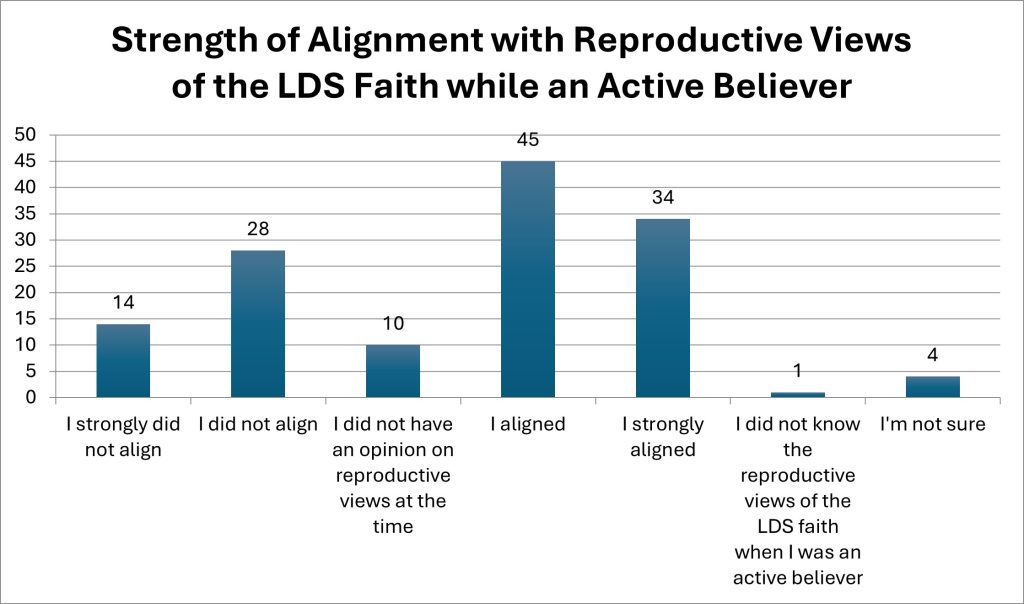
Figure 3: Number of Siblings
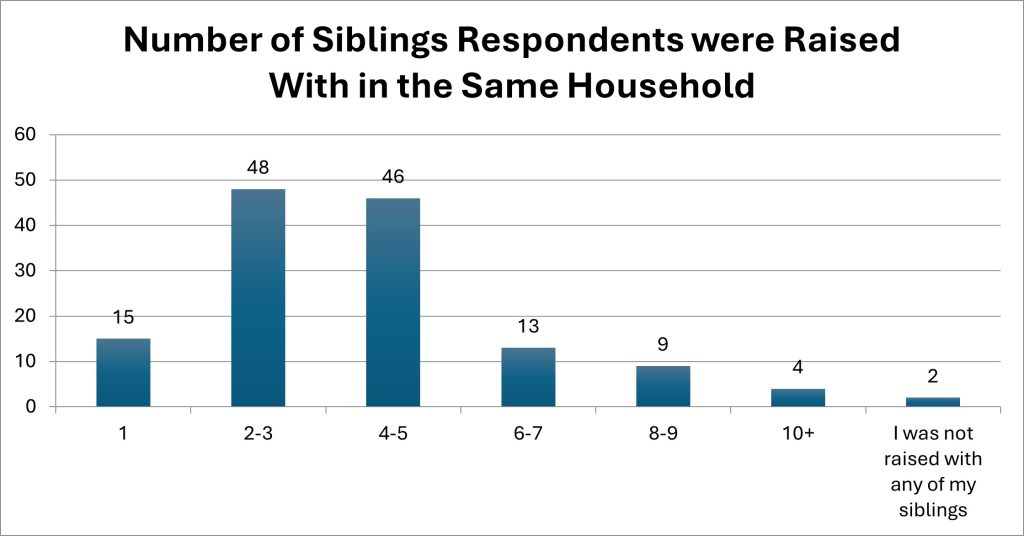
Figure 4: Frequency of Socialization
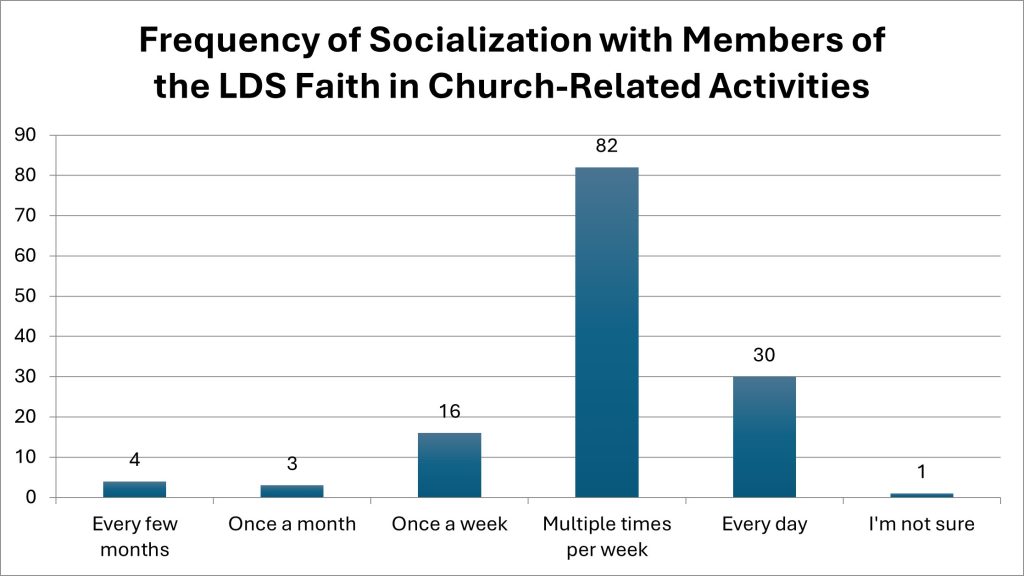
Figure 5: Sex and Sexuality
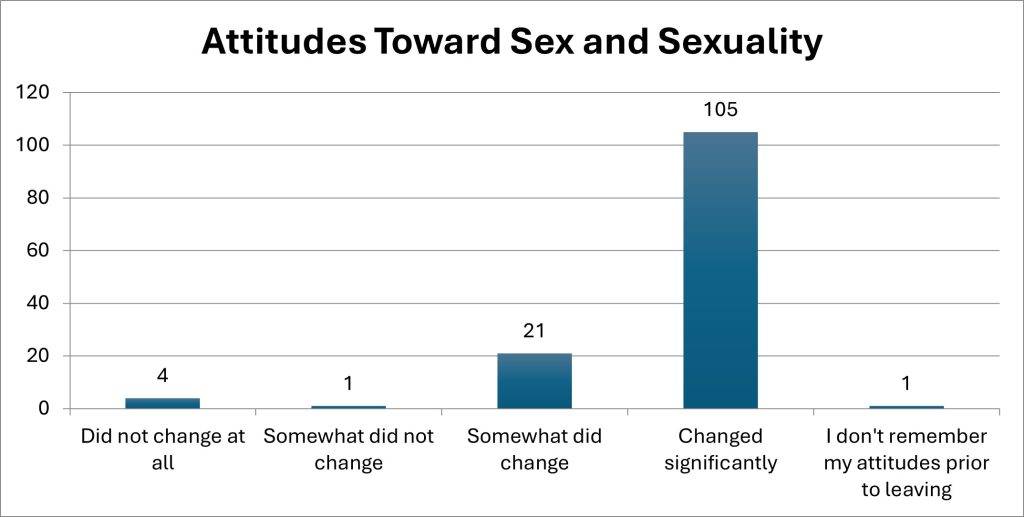
Figure 6: Abstinence
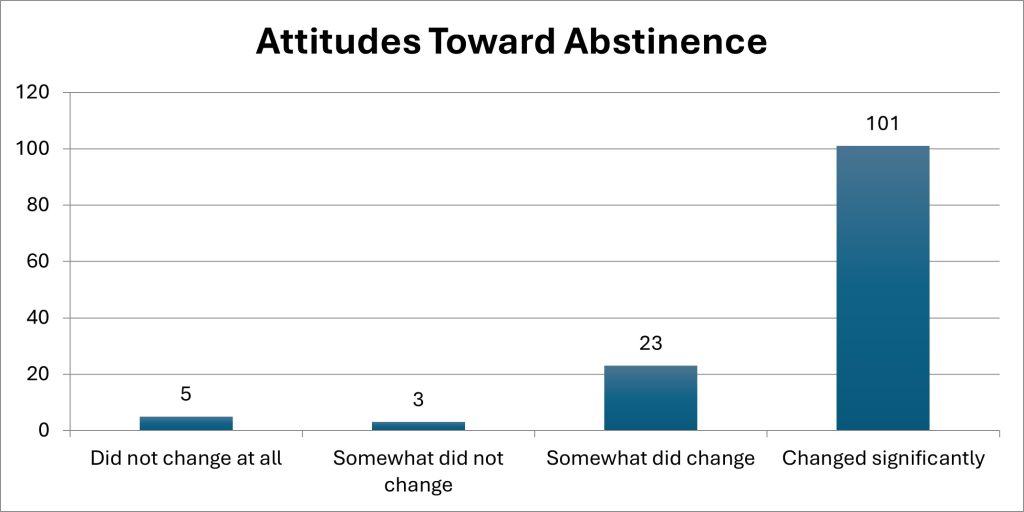
Figure 7: Premarital Sex
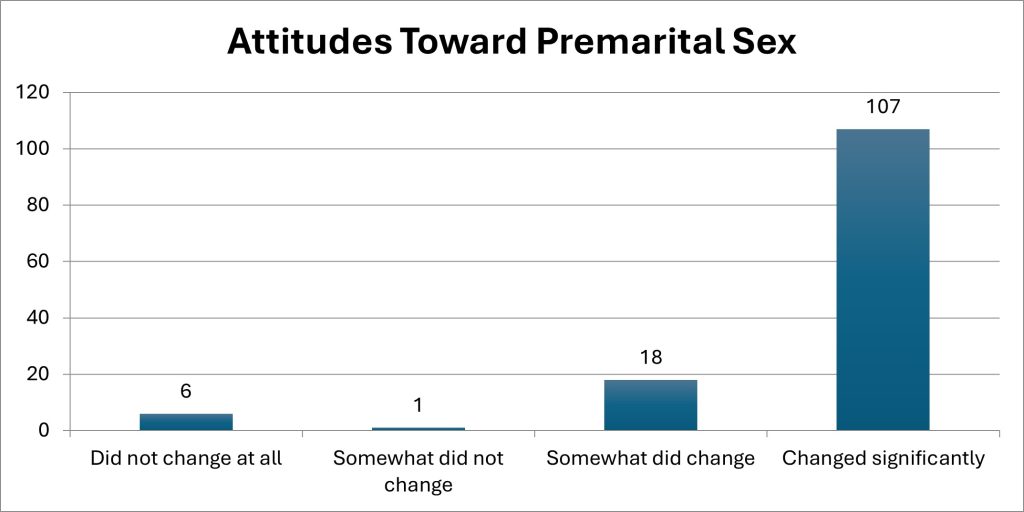
Figure 8: Marriage
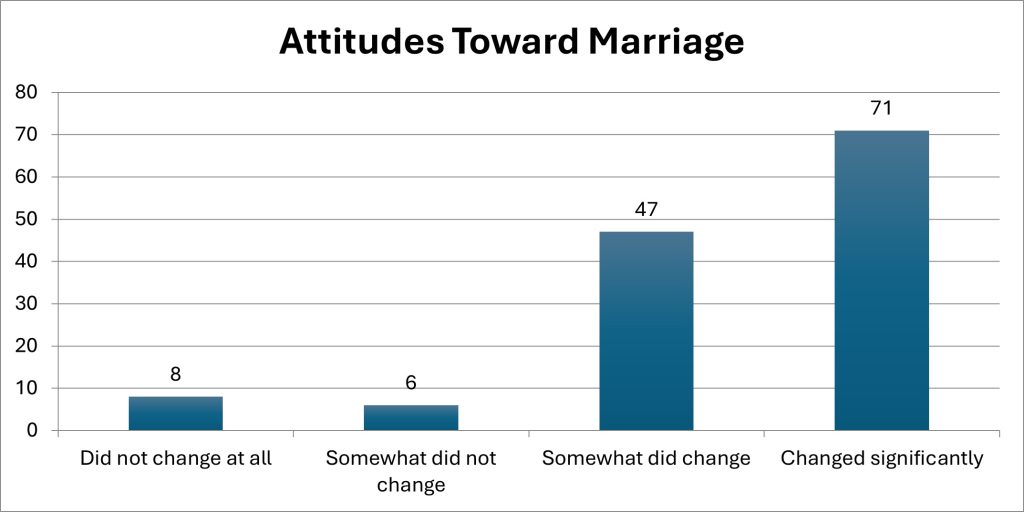
Figure 9: Parenting or Having Children
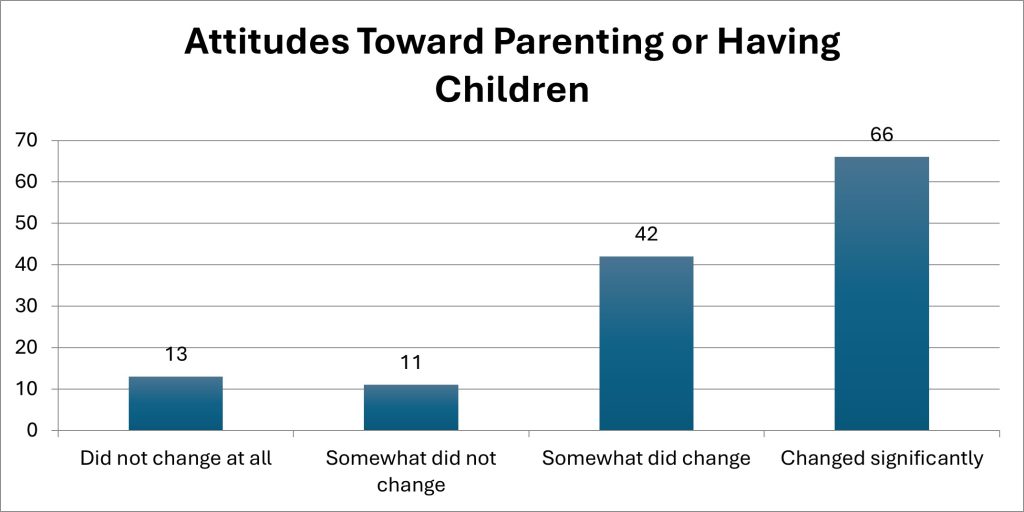
Figure 10: Adoption
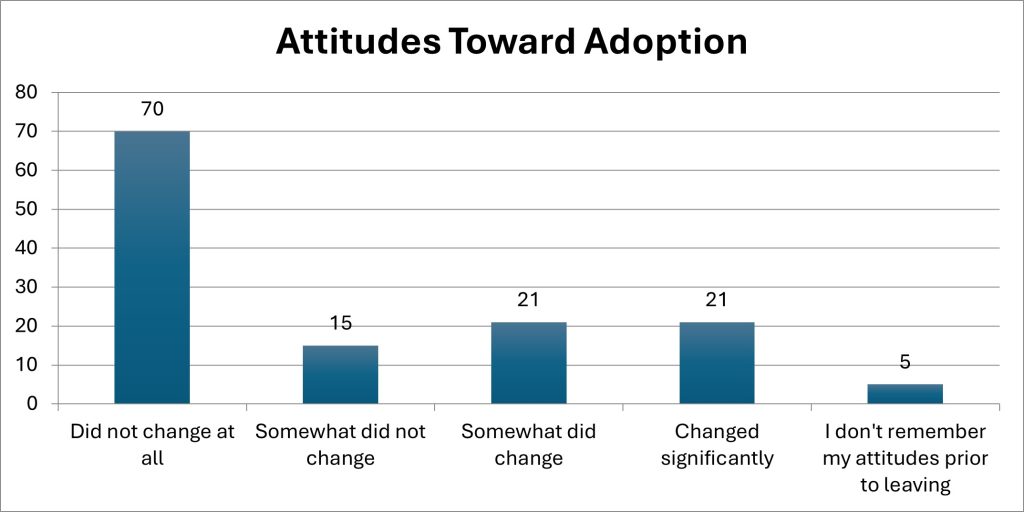
Figure 11: Certain Number of Children
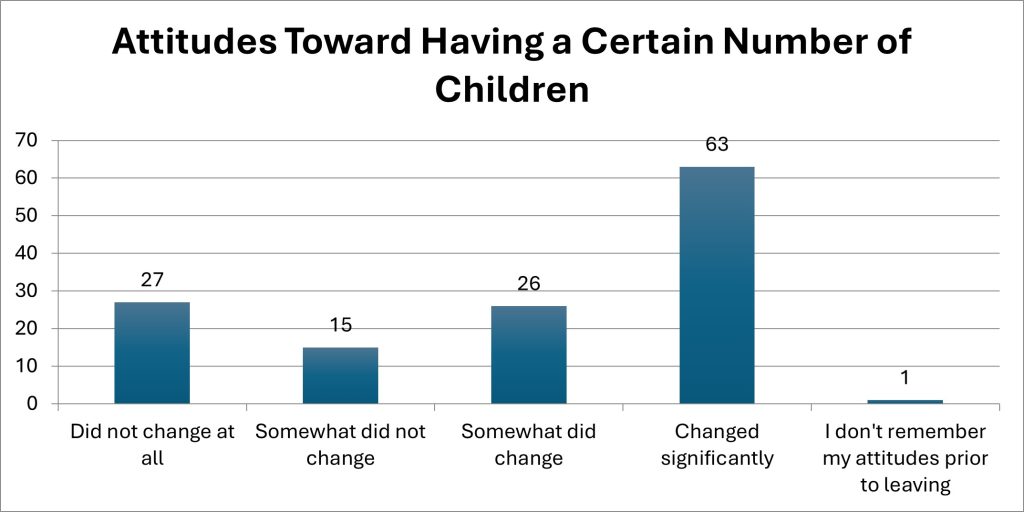
Figure 12: Birth Control
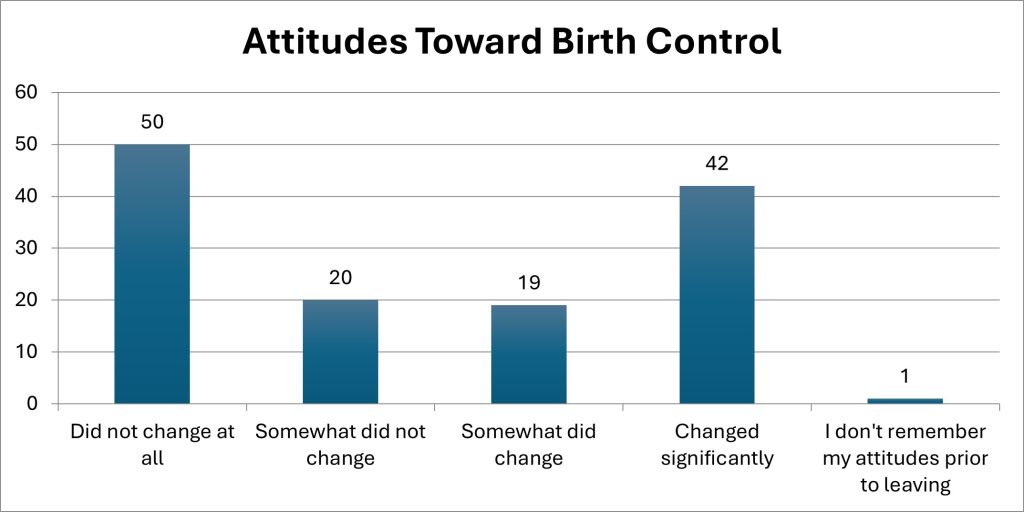
Figure 13: Age
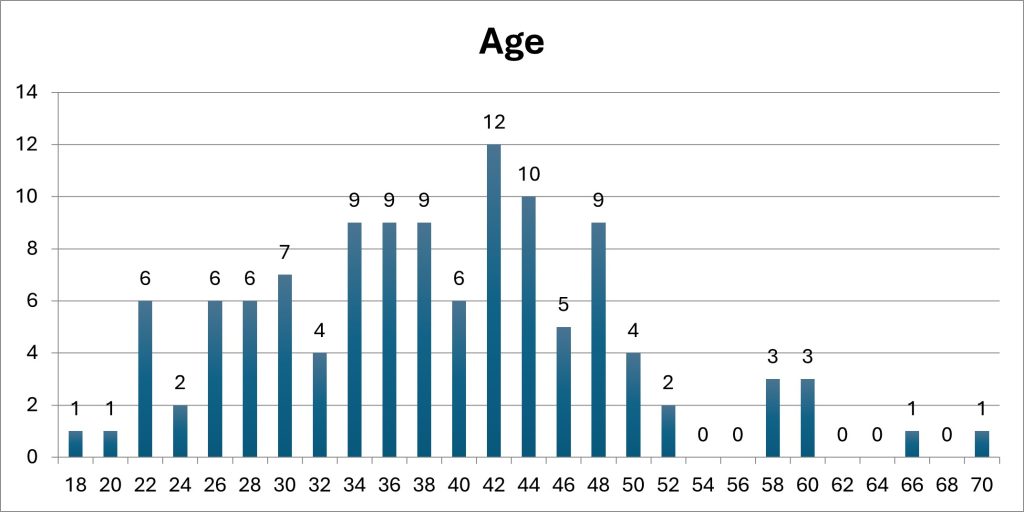
Figure 14: Employment Status
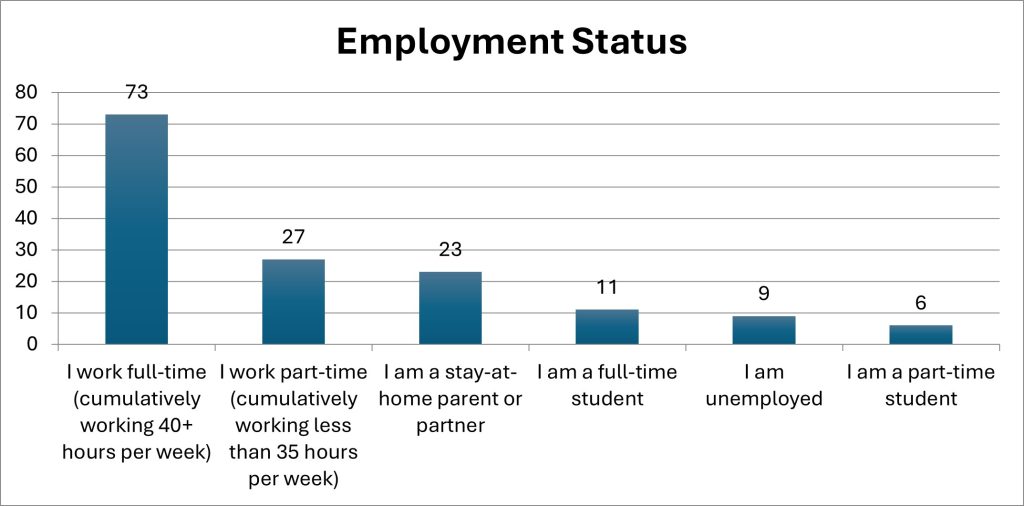
Figure 15: Education
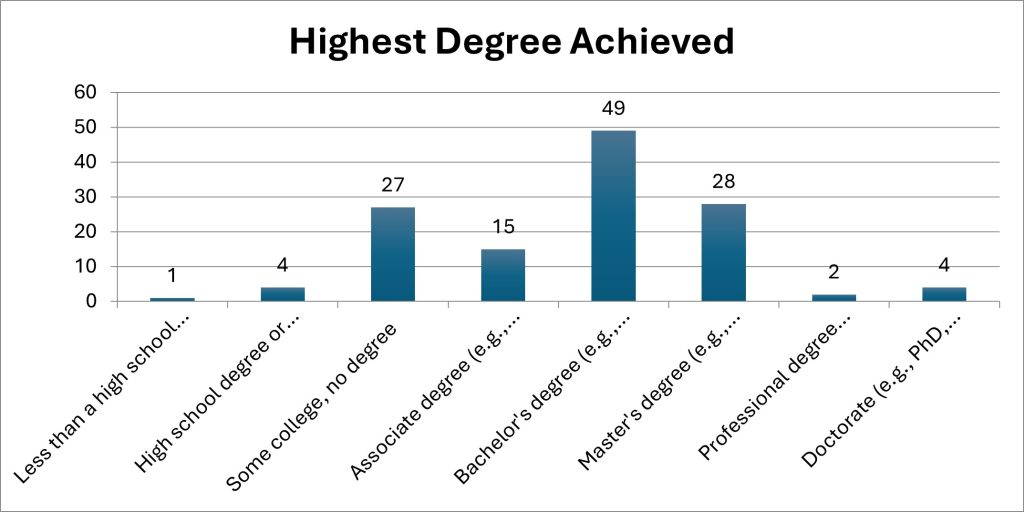
Figure 16: Gender Identity
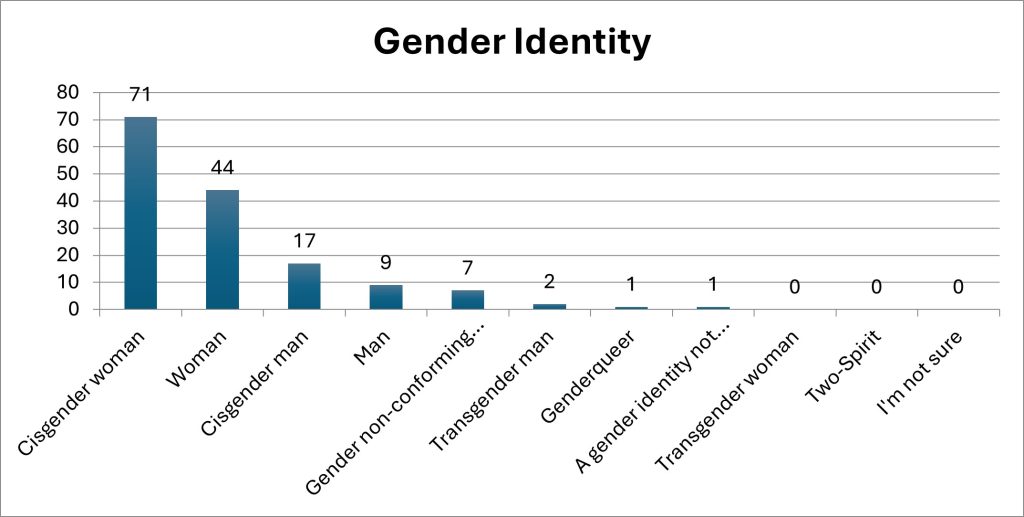
Figure 17: Sexual Identity
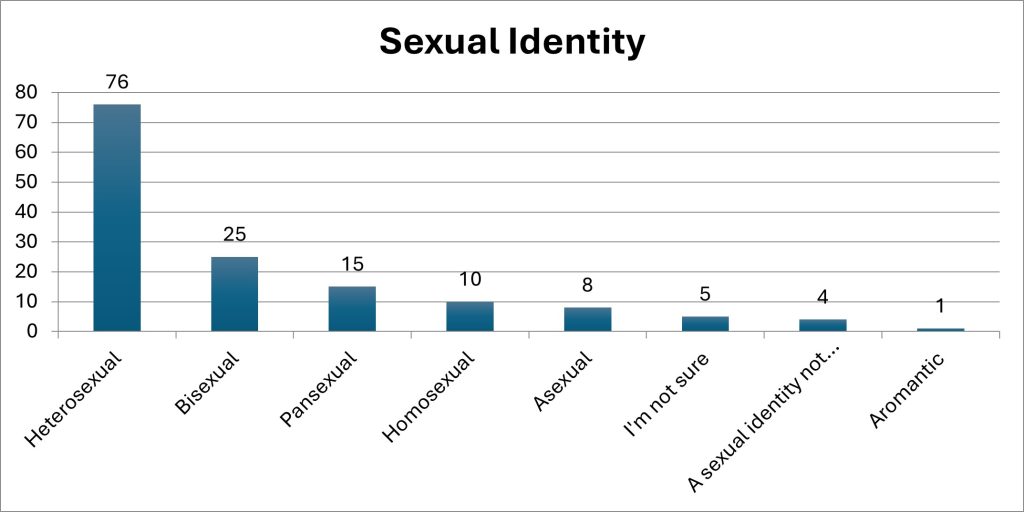
Figure 18: Ethnic Identity
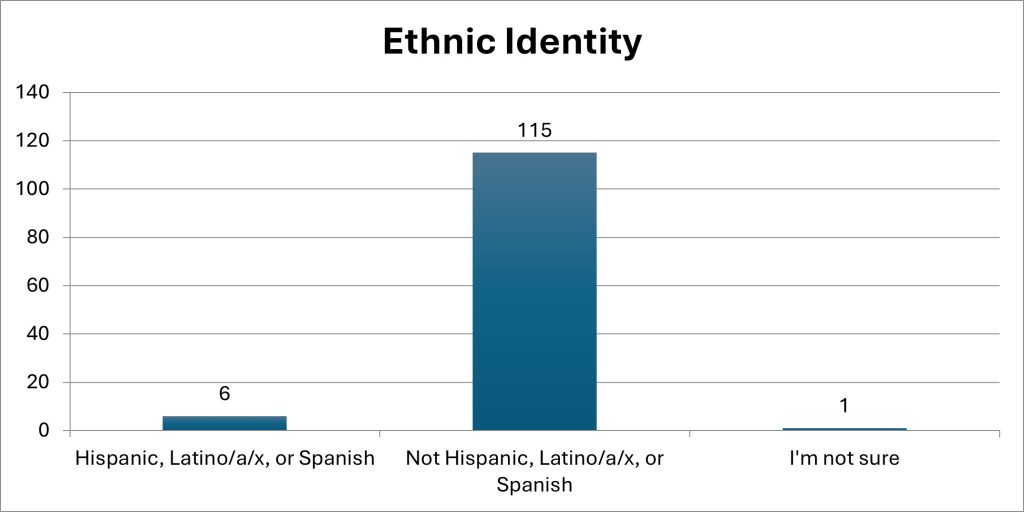
Figure 19: Racial Identity
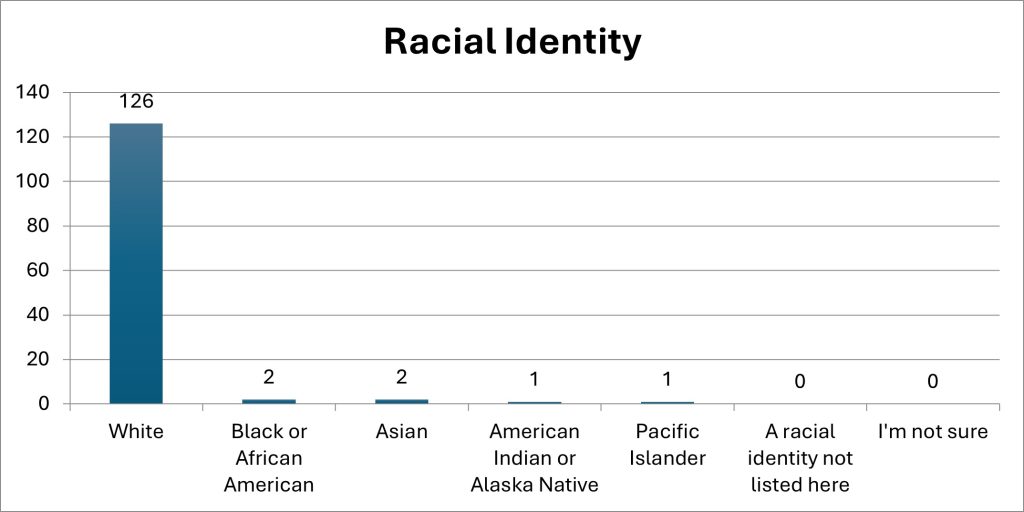
This study focused on three hypotheses. H1 stated that individuals who strongly aligned with the reproductive views of the Church of Jesus Christ of Latter-day Saints when they were active believers will not experience changes in their reproductive views after leaving. Upon running chi- square analyses, we found that there were meaningful changes in attitudes between those who strongly aligned before leaving the faith and those who did not. Specifically, those who were more strongly aligned while they were a believer experienced more changes in their attitudes toward sex and sexuality, abstinence, premarital sex, and birth control (see Fig. 1).
In contrast, with both H2 (individuals who frequently spend time with fellow members of the Latter-day Saint faith in church-related activities will not experience changes in their reproductive views after leaving the faith) and H3 (individuals who frequently spend time with fellow members of the Latter-day Saint faith in church-related activities will not experience changes in their reproductive views after leaving the faith), we found few meaningful differences among the respondents. Those who frequently spent time with fellow members of the LDS faith while a member themselves experienced more changes in their attitudes toward marriage, while those who were raised with a larger number of siblings in the same household for at least five years experienced more changes in their attitudes toward sex and sexuality (see Fig. 1).
Discussion and Conclusion
The purpose of this study was to find the influence that no longer believing in the teachings of the Church of Jesus Christ of Latter-day Saint has on one’s reproductive beliefs and habits, specifically analyzing whether attitudes toward abstinence, premarital sex, marriage, parenting or having children, adoption, having a certain number of children, and birth control change. The basis for running such an investigation is grounded in previous research showing that early life and frequent religious exposures can help internalize pronatalist schemas as well as research investigating the reasons behind the Latter-day Saint tradition’s high fertility rate and other reproductive behaviors. As such, we theorized that strongly aligning with the reproductive views of the faith while a believer, frequent socialization with other members of the faith in church-related activities, and being raised in a household with many children would internalize the reproductive views of the LDS faith in ex- Mormons and PIMOs to such a degree that their reproductive attitudes would not change even upon no longer believing in the theology.
Our analyses show that when it came to the strength of one’s alignment with the reproductive views of the faith while an active believer, our theory was partially supported. How strongly one aligned was associated with whether one changed their attitudes around sex and sexuality, abstinence, premarital sex, and birth control or not once they stopped beliving; the chi-square statistics were statistically significant for these things, which means our theory did not hold true for these attitudes. However, attitudes toward marriage, parenting or having children, adoption, or having a certain number of children were not statistically significant. This means that how strongly one aligned was not associated with changes in attitudes around these things. Thus, if someone stops believing in the LDS faith, despite being socialized with the faith’s reproductive beliefs and strongly aligning with them while a believer, they may experience changes in some of their reproductive beliefs and attitudes.
In contrast, when it came to the frequency of socialization one had with fellow members of the Latter-day Saint faith, our theory was mostly supported. How frequently one socialized with fellow faith members in church-related activities was only associated with whether one meaningfully changed their attitudes toward marriage; only the chi-square statistic for marriage was statistically significant.
Attitudes toward sex and sexuality, abstinence, premarital sex, parenting or having children, adoption, having a certain number of children, and birth control were not shown to be statistically significant, meaning that our participants did not experience meaningful changes in these reproductive beliefs in relation to their frequency of socialization while a member. If someone stops believing in the Church of Jesus Christ of Latter-day Saint theology, they may not experience meaningful changes in their reproductive beliefs and attitudes overall if they frequently socialized with other members of the faith in church-related activities while a believer.
Similarly, when it came to being raised in a family with many siblings, our theory was mostly supported. How many siblings one was raised with was only associated with whether one changed their attitudes toward sex and sexuality; only the chi-square statistic for this was statistically significant. Attitudes toward abstinence, premarital sex, marriage, parenting or having children, adoption, having a certain number of children, and birth control were not shown to be statistically significant, meaning that our participants did not experience significant changes in these reproductive beliefs in relation to the number of siblings they were raised with. If someone stops believing in the Latter-day Saint faith, they may not experience meaningful changes in their reproductive beliefs and attitudes overall if they have many siblings.
Based on these results, our theory that different aspects of socialization can internalize the reproductive views of the Church of Jesus Christ of Latter-day Saint tradition so that they remain even in those who no longer believe in the theology may hold true. This may be most likely for attitudes toward parenting or having children, adoption, and having a certain number of children, for these attitudes did not experience significant changes across all three sets of hypotheses. Furthermore, when it came to one’s frequency of socialization and how many siblings the respondents were raised with, a majority of their reproductive attitudes did not experience meaningful changes, either. Further research is necessary to see whether former believers of the LDS faith, whether that be ex-Mormons and/or PIMOs, are experiencing significant changes in their reproductive attitudes compared to when they were active believers, and future research should investigate the socialization factors behind why those attitudes are changing or not. Future research should also investigate whether fully leaving the faith versus only no longer believing in it impacts one’s reproductive beliefs and habits, as well.
Certain characteristics of our sample population may be why these specific results were produced, however. Our sample was quite small, which may impact the statistical rigor of the results. Future studies on this topic should pursue an increased number of participants. Additionally, a majority of the sample was female. Those assigned female at birth have been traditionally viewed as responsible for what reproductive decisions happen with their bodies and thus may possess or express distinctive opinions regarding reproductive beliefs and habits, which may influence the results found here; a more gender-diverse sample may find that certain attitudes change differently than what was observed in this study.
Finally, while the survey was advertised so that only those between the ages of 18-49 were desired, approximately 12% of the sample was older than that. We chose the 18-49 age range because of the total fertility rate, which is a standard demographic indicator that estimates the average number of children a woman will have during her likely reproductive years—the ages of 15-49. To avoid potential undue influence or coercion by including minors in this study, we decided to decrease the reproductive years range stated in the total fertility to what we termed the adult reproductive years: 18-
49. However, since a number of participants were older than that range, it is possible that these individuals stopped believing in the faith after no longer actively making reproductive decisions, which may have influenced whether their attitudes changed around the reproductive behaviors investigated here. More research is needed with constraints regarding age and/or whether one was still making reproductive decisions upon no longer believing in the Latter-day Saint theology.
To truly understand the current and future fertility and reproductive attitudes of both current and former believers in the Church of Jesus Christ of Latter-day Saints, further research is necessary to truly test the theory that certain aspects of the theology can become so internalized due to certain socialization factors that they carry over even after individuals no longer believe in the theology.
Direct comparisons to active members’ reproductive beliefs may be necessary to identify how such internalization functions, as well.
References
Bean, L. L., Mineau, G., & Anderton, D. (1983). Residence and religious effects on declining family size: An historical analysis of the Utah population. Review of Religious Research, 25(2), 91–101. https://doi.org/10.2307/3511487
Church News Staff. (2021, June 18). Where do the largest percentages of Latter-day saints live? newsroom.churchofjesuschrist.org. Retrieved March 9, 2023, from https://newsroom.churchofjesuschrist.org/article/where-do-the-largest-percentages-of-latter-day- saints-live
Harris, E. (2022, August 1). A decade of declining fertility in Utah, the Intermountain West, and the nation: 2010-2020. Kem C. Gardner Policy Institute. Retrieved March 9, 2023, from https://gardner.utah.edu/wp-content/uploads/Fertility-RB-Jul2022.pdf
Hastings, D. W., Reynolds, C. H., & Canning, R. R. (1972). Mormonism and birth planning: The discrepancy between Church authorities’ teachings and lay attitudes. Population Studies, 26(1), 19–28. https://doi.org/10.2307/2172798
Hayford, S. R., & Morgan, S. P. (2008). Religiosity and fertility in the United States: The role of fertility intentions. Social Forces, 86(3), 1163–1188. https://doi.org/10.1353/sof.0.0000
Heaton, T. B. (1986). How does religion influence fertility?: The case of Mormons. Journal for the Scientific Study of Religion, 25(2), 248–258. https://doi.org/10.2307/1385480
Heaton, T. B., & Goodman, K. L. (1985). Religion and family formation: a comparison of Mormons with Catholics and Protestants. Review of Religious Research, 26(4), 343–359. https://doi.org/10.2307/3511049
Pearce, L. D., & Davis, S. N. (2016). How early life religious exposure relates to the timing of first birth. Journal of Marriage and Family, 78(5), 1422–1438. https://doi.org/10.1111/jomf.12364
Pew Research Center. (2014, May). Religious landscape study. Pew Research Center’s Religion & Public Life Project. Retrieved March 9, 2023, from https://www.pewresearch.org/religion/religious-landscape-study/state/utah/
Pew Research Center. (2015, May 12-A). Religious landscape study. Chapter 2: Religious switching and intermarriage. Retrieved March 9, 2023, from https://www.pewresearch.org/religion/2015/05/12/chapter-2-religious-switching-and- intermarriage/
Pew Research Center. (2015, May 12-B). Religious landscape study. Chapter 3: Demographic profiles of religious groups. Retrieved March 9, 2023, from https://www.pewresearch.org/religion/2015/05/12/chapter-3-demographic-profiles-of-religious- groups/#marital-status-and-family-size-of-religious-groups.
Thornton, A. (1979). Religion and fertility: The case of Mormonism. Journal of Marriage and the Family, 41(1), 131–142. https://doi.org/10.2307/351738

